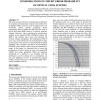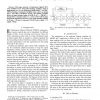CIIT
2004
14 years 26 days ago
2004
( )1 The most common metric for evaluating the performance of an optical communications system is the symbol error probability (SEP) versus the received optical power. In circuit-l...
DPHOTO
2010
14 years 27 days ago
2010
Recent research demonstrates the advantage of designing electro-optical imaging systems by jointly optimizing the optical and digital subsystems. The optical systems designed usin...
BROADNETS
2006
IEEE
14 years 3 months ago
2006
IEEE
Traffic grooming continues to be a rich area of research in the context of WDM optical networks. We provide an overview of the optical and electronic grooming techniques available...
CVPR
2007
IEEE
14 years 3 months ago
2007
IEEE
In the paper, we describe an optical system which is capable of providing external access to both the sensor and the lens aperture (i.e., projection center) of a conventional came...
ISCAS
1994
IEEE
14 years 3 months ago
1994
IEEE
Abstract-- This paper presents a Synchronous Optical NETwork (SONET) OC-3 155.52 Mb/s limiting amplifier, which is
IPPS
1999
IEEE
14 years 3 months ago
1999
IEEE
Abstract. Advances in optical technology, such as low loss Optical Passive Star couplers OPS and the possibility of building tunable optical transmitters and receivers have increas...
IPPS
2000
IEEE
14 years 3 months ago
2000
IEEE
In this paper, we present a new packaging architecture for chip-level optical interconnections based on imaging fiber bundles. Imaging fiber bundles consist of densely packed arra...
INFOCOM
2003
IEEE
14 years 4 months ago
2003
IEEE
Abstract— Aggregation of individual wavelengths into wavebands for their subsequent switching and routing as a single group is an attractive way for scalable and cost-efficient ...
NIME
2004
Springer
14 years 4 months ago
2004
Springer
This report presents a novel interface for musical performance which utilizes a record-player turntable augmented with a computation engine and a high-density optical sensing arra...
DAC
2004
ACM
14 years 4 months ago
2004
ACM
As the technology migrates into the deep submicron manufacturing (DSM) era, the critical dimension of the circuits is getting smaller than the lithographic wavelength. The unavoid...





